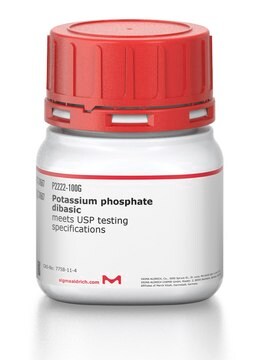P5504
Potassium phosphate dibasic trihydrate
ReagentPlus®, ≥99.0%
Synonym(s):
Dipotassium hydrogen phosphate trihydrate, Dipotassium phosphate, di-Potassium hydrogen phosphate trihydrate
About This Item
Recommended Products
Quality Level
product line
ReagentPlus®
Assay
≥99.0%
form
powder or crystals
pH
9.2-9.4 (25 °C, 50 g/L)
solubility
water: 100 mg/mL, clear, colorless
storage temp.
room temp
SMILES string
O.O.O.[K+].[K+].OP([O-])([O-])=O
InChI
1S/2K.H3O4P.3H2O/c;;1-5(2,3)4;;;/h;;(H3,1,2,3,4);3*1H2/q2*+1;;;;/p-2
InChI key
XQGPKZUNMMFTAL-UHFFFAOYSA-L
Looking for similar products? Visit Product Comparison Guide
Related Categories
General description
Application
Legal Information
Storage Class Code
13 - Non Combustible Solids
WGK
WGK 1
Flash Point(F)
Not applicable
Flash Point(C)
Not applicable
Personal Protective Equipment
Choose from one of the most recent versions:
Already Own This Product?
Find documentation for the products that you have recently purchased in the Document Library.
Customers Also Viewed
Protocols
Proteases break peptide bonds. In the lab, it is often necessary to measure and/or compare the activity of proteases. Sigma's non-specific protease activity assay may be used as a standardized procedure to determine the activity of proteases, which is what we do during our quality control procedures.
Enzymatic Assay of Superoxide Dismutase
To standardize a procedure for the enzymatic assay of Protease using Casein as a substrate.
Our team of scientists has experience in all areas of research including Life Science, Material Science, Chemical Synthesis, Chromatography, Analytical and many others.
Contact Technical Service




